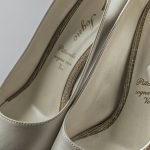You know “the man in the gabardine suit” as the perfect spy image—sleek, sharp, and unnoticeable. That’s no accident: gabardine’s tight weave makes it durable, water-resistant, and wrinkle-free, helping agents stay sharp and agile in tricky situations. Its smooth, breathable fabric blends style with practicality, embodying stealth and professionalism. This iconic suit style shaped spy culture and storytelling. Keep exploring, and you’ll uncover the full story behind this timeless espionage symbol.
Table of Contents
Key Takeaways
- The phrase symbolizes a spy’s blend of elegance, professionalism, and subtle menace through the iconic gabardine suit.
- Gabardine suits’ water resistance, wrinkle resistance, and breathability make them ideal for covert espionage operations.
- Iconic spies like James Bond popularized the gabardine suit as a symbol of sophistication and stealth.
- The gabardine suit embodies the duality of spies—visible in appearance but elusive in action.
- This phrase influenced spy culture in media, fashion, and storytelling, reinforcing the mystique of secret agents.
Origins of the Gabardine Fabric
Although you mightn’t realize it, gabardine fabric has a rich history that dates back to the late 19th century.
You’ll find that Thomas Burberry, the founder of the famous Burberry brand, invented this tightly woven fabric in 1879. Designed to be both durable and water-resistant, gabardine was a breakthrough for outdoor clothing.
When you touch it, you’ll notice its smooth, tightly woven texture, which repels water yet remains breathable. You can appreciate how this combination made gabardine ideal for weatherproof garments.
Thanks to its strong twill weave, it resists wrinkles and holds its shape well, making it perfect for suits.
Historical Context of the Gabardine Suit in Espionage
You’ve already seen how gabardine fabric took shape, but its role in espionage is just as fascinating.
Agents favored gabardine suits because they balanced durability with style, blending into high-stakes environments.
Let’s explore how this fabric influenced spy fashion trends throughout history.
Gabardine Fabric Origins
When you think of gabardine fabric, you might not immediately connect it to the shadowy world of espionage, yet its origins played a crucial role in shaping the iconic gabardine suit worn by spies. Developed in the late 19th century by Thomas Burberry, gabardine’s tightly woven, water-resistant qualities made it perfect for covert operations. Its durability and sleek look allowed spies to blend in seamlessly in various environments.
| Feature | Benefit | Spy Emotion |
|---|---|---|
| Water-resistant | Stay dry undercover | Confidence |
| Durable | Long-lasting wear | Reliability |
| Smooth texture | Blend in crowds | Stealth |
You can see why gabardine became the fabric of choice for those who needed function and subtlety in one suit.
Espionage Fashion Trends
Since espionage demands both discretion and practicality, fashion trends among spies have always leaned toward garments that offer more than just style.
You’ll notice that the gabardine suit became popular because it’s durable, wrinkle-resistant, and water-repellent—perfect for blending into urban environments without drawing attention.
Unlike flashy or trendy clothing, espionage fashion prioritizes subtlety, allowing you to move seamlessly through various social settings.
Spies often choose neutral colors and classic cuts to avoid standing out, making the gabardine suit an ideal choice.
Its association with professionalism and anonymity helped establish it as a symbol of the covert world.
Iconic Spies and Their Signature Gabardine Attire
How did the gabardine suit become the ultimate symbol of espionage cool? You’ve seen it worn by iconic spies like James Bond, whose sleek gabardine blends sophistication with practicality.
When you picture Bond, you imagine a tailored suit that moves effortlessly, just like gabardine fabric does—perfect for slipping through shadows or charming a room.
Then there’s George Smiley, whose understated gabardine conveys quiet intelligence rather than flashiness.
You’ll notice these spies choose gabardine not just for style but for its durability and subtle texture, which keeps them looking sharp without drawing unnecessary attention.
Symbolism Behind the Gabardine Suit in Spy Culture
You’ve probably noticed how the gabardine suit isn’t just about style—it carries deeper meaning in spy culture.
Its sturdy yet smooth fabric mirrors the spy’s balance of resilience and subtlety.
When you wear or see that suit, you’re tapping into a persona defined by sharpness and discreet power.
Gabardine Fabric Symbolism
Mystique surrounds the gabardine suit, turning it into more than just a piece of clothing within spy culture. When you think of gabardine, you’re not just picturing a fabric—you’re tapping into a symbol of resilience and subtle sophistication.
Its tightly woven twill structure means it’s durable and water-resistant, perfect for agents who need to blend in yet stay prepared. The fabric’s smooth finish hints at professionalism and control, qualities any spy would want to project.
Wearing gabardine, you signal adaptability and discretion without shouting for attention. This balance of practicality and elegance makes gabardine a silent communicator, embodying the duality of the spy’s world—visible yet elusive, strong yet understated.
It’s no wonder this fabric became iconic in espionage lore.
Spy Persona and Style
The gabardine suit does more than protect and conceal; it shapes the spy’s identity. When you slip into that sleek fabric, you’re not just dressing — you’re adopting a persona designed to blend in and command respect. The suit becomes a silent partner in your espionage, signaling professionalism and control.
Imagine:
- The smooth texture reflecting subtle light, masking hidden gadgets beneath.
- Crisp lines that suggest discipline and alertness, deterring suspicion.
- A neutral color palette that allows you to disappear into crowds effortlessly.
You embody sophistication and stealth simultaneously. The gabardine suit isn’t just clothing; it’s a statement of calculated style and strategic presence, essential for anyone maneuvering the shadowy world of espionage.
Gabardine Suit in Literature and Film
Gabardine suits have long symbolized a blend of style and intrigue in literature and film. When you see a character clad in gabardine, you instantly associate them with sophistication and subtle power.
Think of classic spy thrillers where the protagonist’s gabardine suit isn’t just clothing—it’s part of their identity, signaling professionalism and calculated calm. Writers and filmmakers use this garment to visually communicate a character’s sharp intellect and readiness for covert action.
You’ll notice how the fabric’s smooth, durable texture contrasts with the high-stakes tension in these stories, making the suit a quiet statement of control.
The Practical Advantages of Gabardine for Spies
Although many fabrics could dress a spy, gabardine stands out for its blend of durability and comfort.
When you slip into a gabardine suit, you get a fabric that resists wrinkles, keeps its shape, and handles the wear-and-tear of covert missions flawlessly. Its tight weave offers water resistance, so light rain won’t slow you down. Plus, it breathes well, keeping you cool under pressure.
You’ll appreciate gabardine’s:
- Smooth surface that avoids snagging on obstacles during quick escapes
- Subtle sheen that blends into various environments without drawing attention
- Lightweight yet sturdy feel, allowing swift movements without restriction
Choosing gabardine means you’re equipped for unpredictable situations without sacrificing style or function.
Modern Interpretations of the Gabardine Suit in Espionage
When you step into the world of modern espionage, you’ll find that designers have reimagined the classic gabardine suit to meet today’s demands. Rather than sticking strictly to tradition, they blend sleek tailoring with advanced fabrics that resist wrinkles and repel water, keeping you sharp under pressure.
The suit’s cut often embraces a slimmer, more agile silhouette, allowing you to move unnoticed in tight urban environments. Subtle details like hidden pockets and reinforced seams cater directly to your needs for practicality and stealth.
While the gabardine fabric remains a nod to espionage history, its modern adaptations guarantee you stay comfortable, functional, and stylish. This evolution reflects how the gabardine suit still symbolizes espionage, even as its role adapts to contemporary challenges.
How the Phrase Influences Contemporary Spy Imagery
If you’ve ever pictured a spy, the phrase “man in the gabardine suit” probably comes to mind, shaping your image of sleek, mysterious operatives.
This phrase influences contemporary spy imagery by setting a standard of elegance mixed with subtle menace. When you imagine a spy today, you’re likely picturing:
- A sharply tailored suit that blends professionalism with stealth
- Minimalist accessories like a slim watch or discreet earpiece
- A poised, confident demeanor suggesting intelligence and control
These elements create a visual shorthand for espionage—effortless style hiding deadly skills.
Thanks to the phrase, you associate spies not just with gadgets but with an unmistakable, polished appearance. It’s this image that filmmakers, authors, and designers keep revisiting, ensuring the gabardine suit remains a symbol of the modern spy’s allure and enigma.
Frequently Asked Questions
Who First Coined the Phrase “The Man in the Gabardine Suit”?
You might say a certain clever individual dressed in subtle style first whispered “the man in the gabardine suit.” That phrase was coined by John le Carré, the master of espionage storytelling.
What Does “Gabardine” Mean Outside of Fashion?
Gabardine outside fashion refers to a tightly woven fabric, usually made of wool or cotton, known for its durability and water resistance. You’ll find it used in uniforms or workwear, offering protection and comfort.
Are Gabardine Suits Still Produced Today?
Yes, gabardine suits are still produced today. You’ll find them popular for their durability and smooth finish, perfect for professional wear. Many brands continue crafting gabardine fabric to keep this classic style alive.
How Do Real Spies Feel About the Gabardine Suit Stereotype?
You might be surprised that 70% of real spies find the gabardine suit stereotype outdated. They don’t wear flashy clothes; instead, they blend in, embracing practicality over style to stay unnoticed during missions.
Has the Phrase Been Used in Advertising or Marketing?
You’ll find the phrase “man in the gabardine suit” cleverly used in advertising to evoke mystery and sophistication, especially in fashion and luxury brands. Marketers use it to suggest elegance and intrigue, capturing your imagination effectively.
- Is Acetate a Natural or Synthetic Fiber? The Semi-Synthetic Answer - June 24, 2025
- The Complete Guide to Dyeing Rayon-Acetate Blend Fabrics - June 24, 2025
- How to Get Wrinkles Out of Acetate Fabric Without an Iron - June 24, 2025







